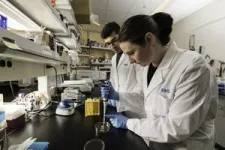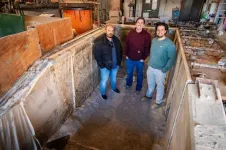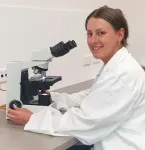(Press-News.org) The University of Rochester will house a new national center focused on using tissue-on-chip technology to develop drugs more rapidly and reduce the need for animal trials. The National Institutes of Health awarded a $7.5 million grant to establish the Translational Center for Barrier Microphysiological Systems (TraCe-bMPS) at Rochester in partnership with Duke University.
The center aims to develop five Food and Drug Administration–qualified drug development tools related to study barrier functions in disease—interfaces in tissue that are critical for the progression of infection, cancer, and many autoimmune disorders. Over the five-year grant, the researchers will create drug development tools specifically related to central nervous system disorders, fibrosis, musculoskeletal autoimmune disease, sepsis, and osteomyelitis.
The TraCe-bMPS scientists will create the drug development tools using microphysiological systems—small chips with ultrathin membranes of human cells. They will be built using the modular, mass-producible µSiM chips pioneered by center director James McGrath, the William R. Kenan Jr. Professor of Biomedical Engineering.
McGrath says that testing drugs on µSiM chips can lead to fewer animal trials. And because researchers will be studying the drugs’ effects on human cells, they may also help overcome some of the critical differences between testing on humans and animals.
“Drug discovery is moving into an era where fewer animals are used to test for safety and efficacy,” says McGrath. “Instead, more screening will be done on tissue chips that pattern human cells in a way that mimics human tissue and disease. Our chips are designed to provide the higher throughput and more reliable indications that pharmaceutical companies need to get their drugs approved for clinical trials and use by patients.”
Hani Awad, the Donald and Mary Clark Distinguished Professor in Orthopaedics and a professor of biomedical engineering, will serve as the associate director for development. He says Congress passing the FDA Modernization Act 2.0 in 2022 made the center possible and that the team is excited to help shape the future of drug development.
“The timing could not be more perfect,” says Awad. “As a biomedical engineer and scientist, I find the elegant fusion of engineering and biology inherent in the design and validation of these tissue chips as disease models and drug-testing platforms to be one of the most rewarding pursuits in my professional career. I can’t wait to see what this team will be developing over the next five years, and beyond.”
The chips will feature photonic biosensors crafted by Benjamin Miller, a Dean’s Professor of Dermatology at Rochester with joint appointments in biomedical engineering, biochemistry and biophysics, optics, and materials science. Miller, the center’s associate director for resources, says the center is the culmination of years of research and collaboration.
“Getting our devices qualified by the FDA as drug development tools will mean that we’re a step closer to doing ‘clinical trials on chip’ with fully human models, increasing the likelihood of a drug candidate being successful when it actually gets to human clinical trials,” says Miller. “This is also a great opportunity to build an interdisciplinary training environment for our students and expand a collaboration with my colleagues that has been very productive.”
Joan Adamo, director of the Office of Regulatory Support at the University of Rochester Medical Center’s Clinical and Translational Science Institute, will serve as associate director for qualification and will prepare all submissions to the FDA for qualification. Adamo says she sees the ambitious program having far-reaching implications.
“This unique program involves close collaboration with the FDA through a series of qualification steps—a critical aspect to addressing unmet needs,” says Adamo. “I am looking forward to working closely with the agency and our collaborators on this regulatory science project. We will achieve qualification of these vital drug development tools, which will accelerate research conducted at URMC and be shared with other academic health centers and industry programs.”
George Truskey, the R. Eugene and Susie E. Goodson Distinguished Professor of Biomedical Engineering at Duke University, will serve as associate director and direct collaborative activities at Duke University. The TRaCE-bMPS is also supported by a deep network of co-investigators at Rochester, Duke, and Rochester Institute of Technology, a distinguished advisory board, expert consultants, and key industry partners. The NIH grant is expected to fund TRaCE-bMPS through fiscal year 2028 (FY28).
The research funding is provided by the National Institute on Aging of the National Institutes of Health under Award Number U2CAG088071. The content in this article is solely the responsibility of the authors and does not necessarily represent the official views of the National Institutes of Health.
END
New NIH-funded center could soon reduce the need for pharmaceutical trials on animals
Rochester is one of four NIH-sponsored centers that aims to produce tissue-on-chip devices as FDA-qualified drug development tools
2024-01-09
ELSE PRESS RELEASES FROM THIS DATE:
Police leaders face challenges when seeking to accommodate community stakeholders
2024-01-09
Police reform movements often focus on improving police-public relationships. These ties are a focus of community policing and procedural justice, two significant reform efforts in policing worldwide over the last three decades. In a new article, researchers examine issues involved in these efforts, especially limitations to communication, and highlight implications for police-community relations.
The article, by researchers at Arizona State University (ASU) and the University of California, Santa Barbara (UCSB), is published in Psychology, Public Policy, and the Law.
“Reform movements that try to improve relationships ...
New book provides roadmap for police management of public order
2024-01-09
Managing public order at large demonstrations, protests, and assemblies is a demanding and necessary task. A new book provides an international review of public order management experiences and effective practices. Through practical examples grounded in multidisciplinary theory and science, the book offers a roadmap to improve police response and increase safety at large gatherings in democratic countries.
The book, Public Order Policing: A Professional's Guide to International Theories, Case Studies, and Best Practices, was edited by researchers at the University of Nevada, Las Vegas (UNLV); ...
Department of Energy announces $24 million for small business research and development grants
2024-01-09
Washington, D.C. – The U.S. Department of Energy (DOE) today announced awards totaling $24 million for small businesses in 30 states and the District of Columbia. The 111 projects funded by DOE’s Office of Science include the development of computing, advanced materials, and scientific instrumentation that will help advance the department’s clean energy mission.
“Small businesses are the cornerstone of America and contribute significantly to the growth of our economy,” said Asmeret Asefaw Berhe, ...
Transatlantic project works to fortify coastal resilience against rising seas
2024-01-09
Climate change is leading to an increase in sea level rise, putting millions of people in danger of severe coastal flooding in coming years.
Sherif Abdelaziz, associate professor in the Charles E. Via, Jr. Department of Civil and Environmental Engineering at Virginia Tech, is collaborating with researchers from Heriot-Watt University in Edinburgh, Scotland, to find solutions to keep coastal areas safe by enhancing the resilience of sea walls against increasing coastal flooding. The PIONEER project is funded by the Engineering and Physical Sciences Research Council and is aiming to be the initial step in a global collaboration to strengthen coastal ...
A Jupiter-sized planet has been hiding a big secret: A 350,000-mile-long tail
2024-01-09
Key takeaways
Astrophysicists have found that a large exoplanet known as WASP-69b is being trailed by a tail of gas seven times as long as the planet itself.
The comet-like tail is the result of the planet’s gas atmosphere being burned off as it passes precariously close to the hot star it orbits and stretched by stellar winds.
By studying this process in real time, scientists can better understand how thousands of other planets in our galaxy have evolved.
WASP-69b is having a hot girl summer that never ends. The huge gaseous exoplanet, roughly the size of Jupiter and approximately ...
How black silicon, a prized material used in solar cells, gets its dark, rough edge
2024-01-09
Researchers at the U.S. Department of Energy’s Princeton Plasma Physics Laboratory (PPPL) have developed a new theoretical model explaining one way to make black silicon, an important material used in solar cells, light sensors, antibacterial surfaces and many other applications.
Black silicon is made when the surface of regular silicon is etched to produce tiny nanoscale pits on the surface. These pits change the color of the silicon from gray to black and, critically, trap more light, an essential feature of efficient solar cells.
While there are many ways to make black silicon, including some that use the ...
The secret to better rural healthcare: Pay doctors to travel from urban to rural areas
2024-01-09
Researchers from University of Oxford, Arizona State University, and University of Iowa published a new Journal of Marketing study that examines how paying doctors to visit rural areas is a cost-effective way to provide reasonable access and effective care to most rural communities.
The study, forthcoming in the Journal of Marketing, is titled “Bringing the Doctor to the Patients: Cardiology Outreach to Rural Areas” and is authored by J. Jason Bell, Sanghak Lee, and Thomas S. Gruca.
Rural health care is in crisis.
Between 2010 and 2015, the death rate from coronary heart disease was significantly ...
Different pain types in multiple sclerosis can cause difficulty staying active
2024-01-09
For patients with multiple sclerosis, a regular exercise routine is important for managing symptoms. Due to different causes of chronic pain though, physical exercise can be more difficult for some.
Research published in the Journal of Pain from the University of Michigan found that widespread pain with nociplastic features, also known as WPNF, can make engaging in physical activity a painful task for some patients with MS.
“WPNF is a chronic and diffuse pain which can be challenging ...
The Frank R. Breul Memorial Prize
2024-01-09
We are pleased to announce that the 2024 Frank R. Breul Memorial Prize has been awarded to Jessica Pac, Sophie Collyer, Lawrence Berger, Kirk O'Brien, Elizabeth Parker, Peter Pecora, Whitney Rostad, Jane Waldfogel, and Christopher Wimer for their article “The Effects of Child Poverty Reductions on Child Protective Services Involvement,” which appears in the March 2023 issue. The prize pays tribute to Professor Breul’s career as an educator, administrator, and editor of the Social Service Review (SSR) while on the faculty of the Crown Family School of Social Work, Policy, and Practice at the ...
New findings reveal koalas’ health risks following bushfires, will aid in future rescue efforts
2024-01-09
DENVER/Jan. 9, 2023 – A new scientific publication featured in Veterinary Sciences will guide future wildlife rescue and rehabilitation after Australian bushfires. These findings provide critical information for improving koala care during subsequent fire seasons.
Natasha Speight, a Senior Lecturer at the University of Adelaide’s School of Animal and Veterinary Sciences, spearheaded the study, analyzing clinical data from koalas affected by the recent Australian bushfires. Beyond generalized skin burns, the study revealed severe footpad burns, hindering koalas’ tree-climbing abilities and escape from fires. The study ...
LAST 30 PRESS RELEASES:
How do health care professionals determine eligibility for MAiD?
Microplastics detected in rural woodland
JULAC and Taylor & Francis sign open access agreement to boost the impact of Hong Kong research
Protecting older male athletes’ heart health
KAIST proposes AI-driven strategy to solve long-standing mystery of gene function
Eye for trouble: Automated counting for chromosome issues under the microscope
The vast majority of US rivers lack any protections from human activities, new research finds
Ultrasound-responsive in situ antigen "nanocatchers" open a new paradigm for personalized tumor immunotherapy
Environmental “superbugs” in our rivers and soils: new one health review warns of growing antimicrobial resistance crisis
Triple threat in greenhouse farming: how heavy metals, microplastics, and antibiotic resistance genes unite to challenge sustainable food production
Earthworms turn manure into a powerful tool against antibiotic resistance
AI turns water into an early warning network for hidden biological pollutants
Hidden hotspots on “green” plastics: biodegradable and conventional plastics shape very different antibiotic resistance risks in river microbiomes
Engineered biochar enzyme system clears toxic phenolic acids and restores pepper seed germination in continuous cropping soils
Retail therapy fail? Online shopping linked to stress, says study
How well-meaning allies can increase stress for marginalized people
Commercially viable biomanufacturing: designer yeast turns sugar into lucrative chemical 3-HP
Control valve discovered in gut’s plumbing system
George Mason University leads phase 2 clinical trial for pill to help maintain weight loss after GLP-1s
Hop to it: research from Shedd Aquarium tracks conch movement to set new conservation guidance
Weight loss drugs and bariatric surgery improve the body’s fat ‘balance:’ study
The Age of Fishes began with mass death
TB harnesses part of immune defense system to cause infection
Important new source of oxidation in the atmosphere found
A tug-of-war explains a decades-old question about how bacteria swim
Strengthened immune defense against cancer
Engineering the development of the pancreas
The Journal of Nuclear Medicine ahead-of-print tip sheet: Jan. 9, 2026
Mount Sinai researchers help create largest immune cell atlas of bone marrow in multiple myeloma patients
Why it is so hard to get started on an unpleasant task: Scientists identify a “motivation brake”
[Press-News.org] New NIH-funded center could soon reduce the need for pharmaceutical trials on animalsRochester is one of four NIH-sponsored centers that aims to produce tissue-on-chip devices as FDA-qualified drug development tools





